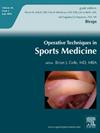膝关节夹层性骨软骨炎的外科治疗进展
IF 0.7
4区 医学
Q4 SPORT SCIENCES
引用次数: 0
摘要
膝关节骨软骨炎是一种具有挑战性的条件下治疗骨骼未成熟和成熟的个体。指导治疗原则是改善病变的生物学和稳定性。影像学和关节镜评估的进步有助于外科医生治疗这些方面的骨软骨炎病变。然而,最佳治疗的证据水平总体上仍然很低。关节镜和开放技术均可用于治疗这些病变。软骨下钻孔、注射骨髓浓缩液、关节后或开放式骨移植清创都被描述为生物增强的方法。生物可吸收和金属植入物穿过病变的子代和亲代方面,以及表面压缩缝合固定可能是增加病变稳定性的适当技术。这些技术被进一步描述,并认识到关于适应症和结果的进一步研究仍在进行中。本文章由计算机程序翻译,如有差异,请以英文原文为准。
Advances in Surgical Treatment of Osteochondritis Dissecans of the Knee
Osteochondritis dissections of the knee is a challenging condition to treat in both skeletally-immature and mature individuals. Guiding treatment principles are the improvement of both the biology and stability of the lesion. Advances in both imaging and arthroscopic assessment have aided surgeons in the treatment of these aspects of osteochondritis lesions. However, level of evidence for best treatment remains low overall. Both arthroscopic and open techniques may be utilized to treat these lesions. Subchondral drilling, injection of bone marrow aspirate concentrate, and debridement with retro-articular or open bone grafting have all been described as methods of biologic augmentation. Bioabsorbable and metallic implants traversing the progeny and parent aspects of the lesion, as well as surface compressive suture fixation may be appropriate techniques for augmenting lesion stability. These techniques are further described with recognition that further study regarding indications and outcomes remains ongoing.
求助全文
通过发布文献求助,成功后即可免费获取论文全文。
去求助
来源期刊
CiteScore
0.60
自引率
0.00%
发文量
46
审稿时长
93 days
期刊介绍:
Operative Techniques in Sports Medicine combines the authority of a textbook, the usefulness of a color atlas and the timeliness of a journal. Each issue focuses on a single clinical condition, offering several different management approaches. It''s the easiest way for practitioners to stay informed of the latest surgical advancements and developments.

 求助内容:
求助内容: 应助结果提醒方式:
应助结果提醒方式:


